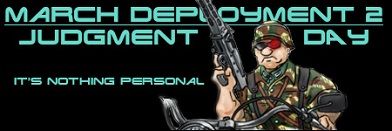Well seeing this thread is back on track I have a question for those who have extensive knowledge of WW2 history. You guys are talking about manufacturing capacities and the like thus I ask the following.
Why did Nazi Germany prefer to focus on expensive and over engineered tanks such as the Panzer IV, Panther, Tiger, Tiger II instead of a single solid tank design meant for mass production?
They Germans never managed to mass produce any tank in the war, the Soviets manufactured roughly 60 000+ T-34s (All variants). The USA took a similar approach by producing nearly 50 000 M4 Sherman (All variants). The Panzer IV production is around 5000, the most produced armoured vehicle was an assault gun, the Stug III whose's production output was around 13 000 (all variants).
Why not try to mass produce the Panzer IV ausf J earlier, instead of the lavish Panzer IV ausf H, Panther and Tiger ?
I would say that by manufacturing several different tanks they put a huge strain on their manufacturing industry seeing the different tank models did not overlap in manufacturing, it was wasteful. But I'm quite uninformed on the manufacturing details So I could be wrong.
I've read online that Hitler himself was obsessed with tanks. He supervised even the tiniest details such as the armour thickness, the guns calibre, and specially names for them during their conception. Which is odd for a Statesman, especially seeing he did not know much about engineering, even less about strategy, let alone grand strategy.
Hitler had a great memory for trivia and figures, which he would use to establish dominance.
I also don't buy into the idea he was strategically inept, plenty of Generals survived to write self serving memoirs that basically set out to say:
Everything we achieved was due our brillance and all the failures were because of Hitler's interfeence. Also I was totally against the atrocities, but those were those nasty SS people not the Army. I would have loved to have killed Hitler but he had bound us all by an oath of loyalty so we could do nothing
Hitler's memoirs would have been no less full of excuplatory BS
Hitler's strategy up until 1941 went pretty well, but strategy is not something the Germans have done well since Bismarck.
Their "strategy" for winning both world wars (post Schliffen) boiled down to "win lots of battles". This leads to a lot of tactical victories with no clear direction.
I remember reading something about his disputes with Guderian on Wikipedia. If I recall correctly Hitler was convinced that tanks gave political advantage and diluted them across several panzer divisions instead of concentrating them on fewer divisions as Guderian wanted.
Hitler wanted to expand the number of Panzer divisions after the fall of France, but he could only do that by cutting the number of tanks in each of them. Guderian argued that this diluted their shock value.
Don't think this was motivated by political considerations though
Was the German high command so incompetent not the see such a gaping flaw in their grand strategy?
Yes
As noted above the Germans didn't do "Grand Strategy"
The Army used it's power to have control over it's own procurement process, and they were not very good at it
Rather than have production engineering to get output you have pursuit of incremental tactical advantage. This means a bunch of small changes that ensure you can never get a proper production run going and hence a bewildering variety of panzer marks
Add to that that the Germans did not properly mobilise or organise until late and they end up using a lot of cobbeled together equipment they have looted from everywhere else.
Logistics, Intelligence and Industrial organisation are great German shortfalls.
Of course organisation of any kind is anathema to Nazi world view anyway, because they are committed to the idea that might makes right so beauracratic infighting is something of a speciality.
























 cblanco ★
cblanco ★  보드카 중대
보드카 중대  VonManteuffel
VonManteuffel  Heartless Jäger
Heartless Jäger 